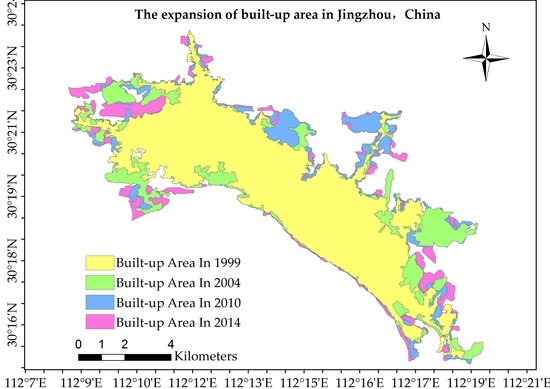Urban Built-Up Area Boundary Extraction and Spatial-Temporal Characteristics Based on Land Surface Temperature Retrieval
Abstract
:1. Introduction
2. Materials and Methods
2.1. Area under Study
2.2. Data Source and Pretreatment
2.3. Method
2.4. Extraction of Urban Built-Up Area Boundary
2.4.1. Rationale of Land Surface Temperature Retrieval
2.4.2. Calculation of Brightness Temperature
2.4.3. Calculation of Atmospheric Transmittance
2.4.4. Calculation of Mean Atmospheric Temperature
2.4.5. Calculation of Ground Emissivity
For Landsat 5 Images and Landsat 7 Images
For Landsat 8 Images
3. Results
3.1. Results of Land Surface Temperature Retrieval
3.2. Urban Built-Up Area Boundary Extraction
4. Discussion
4.1. Overall Trend of Built-Up Area Expansion of Jingzhou
4.2. Spatial and Temporal Characteristics of Built-Up Area Expansion of Jingzhou
4.2.1. Expansion Quantity
4.2.2. Index Calculation
Compactness Index
Fractal Dimension
Barycenter Index of the Built-Up Area
Radial Index
Difference of Spatial Extent of Built-Up Area Expansion
4.3. Rationality Evaluation of the Built-Up Area Expansion of Jingzhou City
4.3.1. Urban Area-Population Elasticity Coefficient
4.3.2. Allometric Growth Model
5. Conclusions
- (1)
- Based on land surface temperature retrieval from the remote sensing images, this study established the procedures for extracting the built-up area boundary of Jingzhou. The Landsat 5, 7 and 8 images were chosen as the data sources by considering the features of the study area, research goals, requirements on remote sensing images for retrieval and availability of the remote sensing images. After pretreatment, the land surface temperature maps of Jingzhou in different years were calculated by using the mono-window algorithm. The threshold method was used to extract the built-up area from the remote sensing images.
- (2)
- Urban sprawl of Jingzhou uses the 1999 built-up area as the core, and the expansion rate differs in different directions. The expansion is the fastest along the axial direction. The expansion quantity and expansion rate both increase initially, then decrease. The development trend of the expansion speed is extra high-speed (urban expansion intensity >1.92) and high-speed (1.05 < urban expansion intensity < 1.92) and then extra high-speed. With a gradual improvement of the urbanization level, the intensity of the expansion initially increases, then decreases. There seems to be a trend of growing compactness over time for the spatial form of the built-up area, with the contour of the built-up area becoming increasingly regular. From 1999–2014, the spatial form of the built-up area evolves towards a more compact and orderly state. The barycenter of the built-up area barely shifts over time, indicating that extension from the initial site of the built-up area is the dominant form of expansion. However, over the past 15 years, the spatial extent of the built-up area has significantly differed in different directions. The expansion is the fastest in the east-south-east direction, followed by that in the west-north-west direction; the expansion in the west-south-south direction is the slowest.
- (3)
- According to the calculation of the urban area-population elasticity coefficient, the urban sprawl of Jingzhou is much faster than the population growth rate. The algometric growth model has proven this. In conclusion, the expansion of Jingzhou’s built-up area is too fast for the local population growth.
Acknowledgments
Author Contributions
Conflicts of Interest
References
- Jensen, J.R.; Toll, D.L. Detecting residential land-use development at the urban fringe. Photogramm. Eng. Remote Sens. 1982, 48, 629–643. [Google Scholar]
- Marquez, L.O.; Smith, N.C. A framework for linking urban form and air quality. Environ. Model. Softw. 1999, 14, 541–548. [Google Scholar] [CrossRef]
- Singh, A. Digital change detection techniques using remotely-sensed data. Int. J. Remote Sens. 1989, 10, 989–1003. [Google Scholar] [CrossRef]
- Masek, J.; Lindsay, F.; Goward, S. Dynamics of urban growth in the Washington DC metropolitan area, 1973–1996, from Landsat Observations. Int. J. Remote Sens. 2000, 21, 3473–3486. [Google Scholar] [CrossRef]
- Zha, Y.; Gao, J.; Zhang, Y. Grassland productivity in an alpine environment in response to climate change. Area 2005, 37, 332–340. [Google Scholar] [CrossRef]
- Huang, X.; Schneider, A.; Friedl, M.A. Mapping sub-pixel urban expansion in China using MODIS and DMSP/OLS nighttime lights. Remote Sens. Environ. 2016, 175, 92–108. [Google Scholar] [CrossRef]
- Jing, W.; Yang, Y.; Yue, X.; Zhao, X.D. Mapping Urban Areas with Integration of DMSP/OLS Nighttime Light and MODIS Data Using Machine Learning Techniques. Remote Sens. 2015, 7, 12419–12439. [Google Scholar] [CrossRef]
- Lu, D.; Tian, H.; Zhou, G.; Ge, H. Regional mapping of human settlements in southeastern China with multisensor remotely sensed data. Remote Sens. Environ. 2008, 112, 3668–3679. [Google Scholar] [CrossRef]
- Hall, P. The future of the metropolis and its form. Reg. Stud. 1997, 31, 211–220. [Google Scholar] [CrossRef]
- Bourne, L.S. Reurbanization, uneven urban development, and the debate on new urban forms. Urban Geogr. 1996, 17, 690–713. [Google Scholar] [CrossRef]
- Braimoh, A.K.; Onishi, T. Spatial determinants of urban land use change in Lagos, Nigeria. Land Use Policy 2007, 24, 502–515. [Google Scholar] [CrossRef]
- Kuang, W.; Liu, Y.; Dou, Y.; Chi, W.; Chen, G.; Gao, C.; Yang, T.; Liu, J.; Zhang, R. What are hot and what are not in an urban landscape: Quantifying and explaining the land surface temperature pattern in Beijing, China. Landsc. Ecol. 2015, 30, 357–373. [Google Scholar] [CrossRef]
- Wang, N.; Wu, H.; Nerry, F.; Li, C.; Li, Z.-L. Temperature and emissivity retrievals from hyperspectral thermal infrared data using linear spectral emissivity constraint. IEEE Trans. Geosci. Remote Sens. 2011, 49, 1291–1303. [Google Scholar] [CrossRef]
- Zhang, Y.; Chen, L.; Wang, Y.; Chen, L.; Yao, F.; Wu, P.; Wang, B.; Li, Y.; Zhou, T.; Zhang, T. Research on the contribution of urban land surface moisture to the alleviation effect of urban land surface heat based on Landsat 8 data. Remote Sens. 2015, 7, 10737–10762. [Google Scholar] [CrossRef]
- Li, Z.-L.; Tang, B.-H.; Wu, H.; Ren, H.; Yan, G.; Wan, Z.; Trigo, I.F.; Sobrino, J.A. Satellite-derived land surface temperature: Current status and perspectives. Remote Sens. Environ. 2013, 131, 14–37. [Google Scholar] [CrossRef]
- Wu, H.; Li, Z.L. Scale issues in remote sensing: A review on analysis, processing and modeling. Sensors (Basel) 2009, 9, 1768–1793. [Google Scholar] [CrossRef] [PubMed]
- Dewan, A.; Corner, R. Dhaka Megacity: Geospatial Perspectives on Urbanisation, Environment and Health; Springer: Berlin, Germany, 2014. [Google Scholar]
- Gilmore, S.; Saleem, A.; Dewan, A. Effectiveness of DOS (Dark-Object Subtraction) method and water index techniques to map wetlands in a rapidly urbanising megacity with Landsat 8 data. In Proceedings of the Research at Locate’15, Brisbane, Australia, 10–12 March 2015. [Google Scholar]
- Qin, Z.H.; Zhang, M.H.; Karnieli, A.; Berliner, P. Mono-window algorithm for retrieving land surface temperature from Landsat TM6 data. Acta Geogr. Sin. 2001, 56, 466–474. [Google Scholar]
- Qin, Z.; Karnieli, A.; Berliner, P. A mono-window algorithm for retrieving land surface temperature from Landsat TM data and its application to the Israel-Egypt border region. Int. J. Remote Sens. 2001, 22, 3719–3746. [Google Scholar] [CrossRef]
- Wan, Z.; Li, Z.L. A physics-based algorithm for retrieving land-surface emissivity and temperature from EOS/MODIS data. IEEE Trans. Geosci. Remote Sens. 1997, 35, 980–996. [Google Scholar]
- Wang, F.; Qin, Z.; Song, C.; Tu, L.; Karnieli, A.; Zhao, S. An improved mono-window algorithm for land surface temperature retrieval from Landsat 8 thermal infrared sensor data. Remote Sens. 2015, 7, 4268–4289. [Google Scholar] [CrossRef]
- Jiménez-Muñoz, J.C.; Sobrino, J.A. A generalized single-channel method for retrieving land surface temperature from remote sensing data. J. Geophys. Res. Atmos. 2003, 108. [Google Scholar] [CrossRef]
- Sobrino, J.; Jimenezmunoz, J.; Verhoef, W. Canopy directional emissivity: Comparison between models. Remote Sens. Environ. 2005, 99, 304–314. [Google Scholar] [CrossRef]
- Zhang, R.; Tian, J.; Su, H.; Sun, X.; Chen, S.; Xia, J. Two improvements of an operational two-layer model for terrestrial surface heat flux retrieval. Sensors (Basel) 2008, 8, 6165–6187. [Google Scholar] [CrossRef] [PubMed]
- Zhang, Y.; Odeh, I.O.A.; Han, C. Bi-temporal characterization of land surface temperature in relation to impervious surface area, NDVI and NDBI, using a sub-pixel image analysis. Int. J. Appl. Earth Obs. Geoinf. 2009, 11, 256–264. [Google Scholar] [CrossRef]
- Sobrino, J.A.; Raissouni, N.; Li, Z.L. A comparative study of land surface emissivity retrieval from NOAA data. Remote Sens. Environ. 2001, 75, 256–266. [Google Scholar] [CrossRef]
- Baig, M.H.A.; Zhang, L.; Shuai, T.; Tong, Q. Derivation of a tasselled cap transformation based on Landsat 8 at-satellite reflectance. Remote Sens. Lett. 2014, 5, 423–431. [Google Scholar] [CrossRef]
- Cuenca, R.; Ciotti, S.; Hagimoto, Y. Application of Landsat to evaluate effects of irrigation forbearance. Remote Sens. 2013, 5, 3776–3802. [Google Scholar] [CrossRef]
- Nie, Q.; Xu, J. Understanding the effects of the impervious surfaces pattern on land surface temperature in an urban area. Front. Earth Sci. 2014, 9, 276–285. [Google Scholar] [CrossRef]
- Jimenez-Munoz, J.C.; Sobrino, J.A.; Plaza, A.; Guanter, L.; Moreno, J.; Martinez, P. Comparison between fractional vegetation cover retrievals from vegetation indices and spectral mixture analysis: Case study of PROBA/CHRIS data over an agricultural area. Sensors (Basel) 2009, 9, 768–793. [Google Scholar] [CrossRef] [PubMed]
- Lin, G.S. Chinese urbanism in question: State, society, and the reproduction of urban spaces. Urban Geogr. 2007, 28, 7–29. [Google Scholar] [CrossRef]
- Irons, J.R.; Dwyer, J.L.; Barsi, J.A. The next Landsat satellite: The Landsat data continuity mission. Remote Sens. Environ. 2012, 122, 11–21. [Google Scholar] [CrossRef]
- Chander, G.; Markham, B.L.; Helder, D.L. Summary of current radiometric calibration coefficients for Landsat MSS, TM, ETM+, and EO-1 ALI sensors. Remote Sens. Environ. 2009, 113, 893–903. [Google Scholar] [CrossRef]
- Jin, M.; Li, J.; Wang, C.; Shang, R. A practical split-window algorithm for retrieving land surface temperature from Landsat-8 data and a case study of an urban area in China. Remote Sens. 2015, 7, 4371–4390. [Google Scholar] [CrossRef]
- Jimenez-Munoz, J.C.; Sobrino, J.A.; Skokovic, D.; Mattar, C.; Cristobal, J. Land surface temperature retrieval methods from Landsat-8 thermal infrared sensor data. IEEE Geosci. Remote Sens. Lett. 2014, 11, 1840–1843. [Google Scholar] [CrossRef]
- Sobrino, J.A. Minimum configuration of thermal infrared bands for land surface temperature and emissivity estimation in the context of potential future missions. Remote Sens. Environ. 2014, 148, 158–167. [Google Scholar] [CrossRef]
- Sobrino, J.A.; Jimenez-Muoz, J.C.; Soria, G.; Romaguera, M.; Guanter, L.; Moreno, J.; Plaza, A.; Martinez, P. Land surface emissivity retrieval from different VNIR and TIR sensors. IEEE Trans. Geosci. Remote Sens. 2008, 46, 316–327. [Google Scholar] [CrossRef]
- Boyce, R.R.; Clark, W.A.V. The concept of shape in geography. Geogr. Rev. 1964, 54, 561–572. [Google Scholar] [CrossRef]
- Mandelbrot, B.B.; Wheeler, J.A. The Fractal Geometry of Nature; W.H. Freeman: New York, NY, USA, 1982; Volume 147, p. 468. [Google Scholar]
- Li, N.; Qiang, W.I.; Niu, S.W.; Zhang, H.X.; He, H. Trends and features of China’s urban expansion from 1992 to 2012 based on DMSP/OLS data. Int. Proc. Chem. Biol. Environ. Eng. 2016, 91. [Google Scholar] [CrossRef]
- Mu, J.X. Study on the Expansion of Construction Land in Xi’an. Mod. City Res. 2007, 4, 38–42. [Google Scholar]
- Chen, Y.G.; Liu, J.S. Reconstructing Steindl’s model: From the law of allometric growth to the rank-size rule of urban systems. Sci. Geogr. Sin. 2001, 21, 412–416. [Google Scholar]
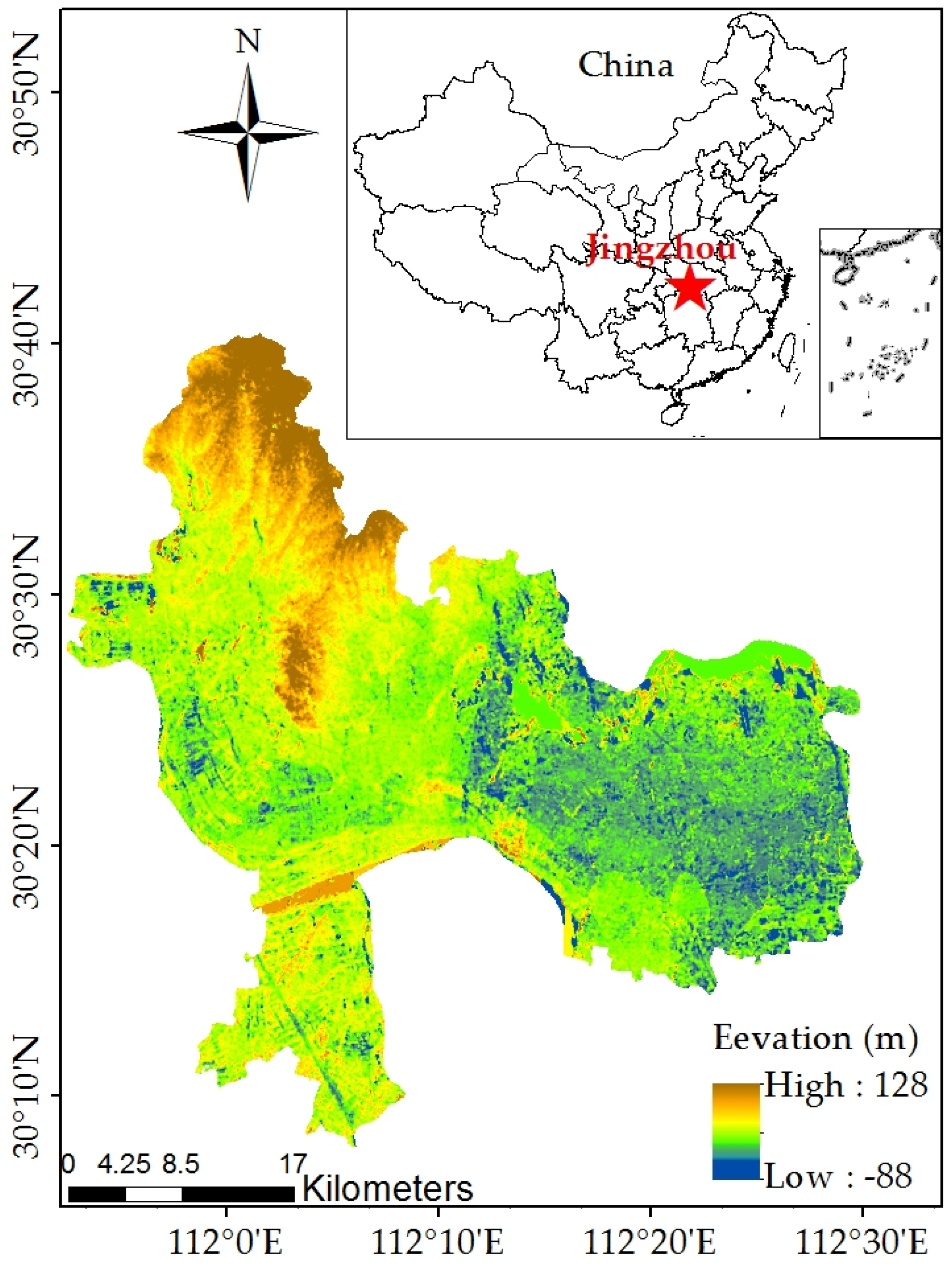

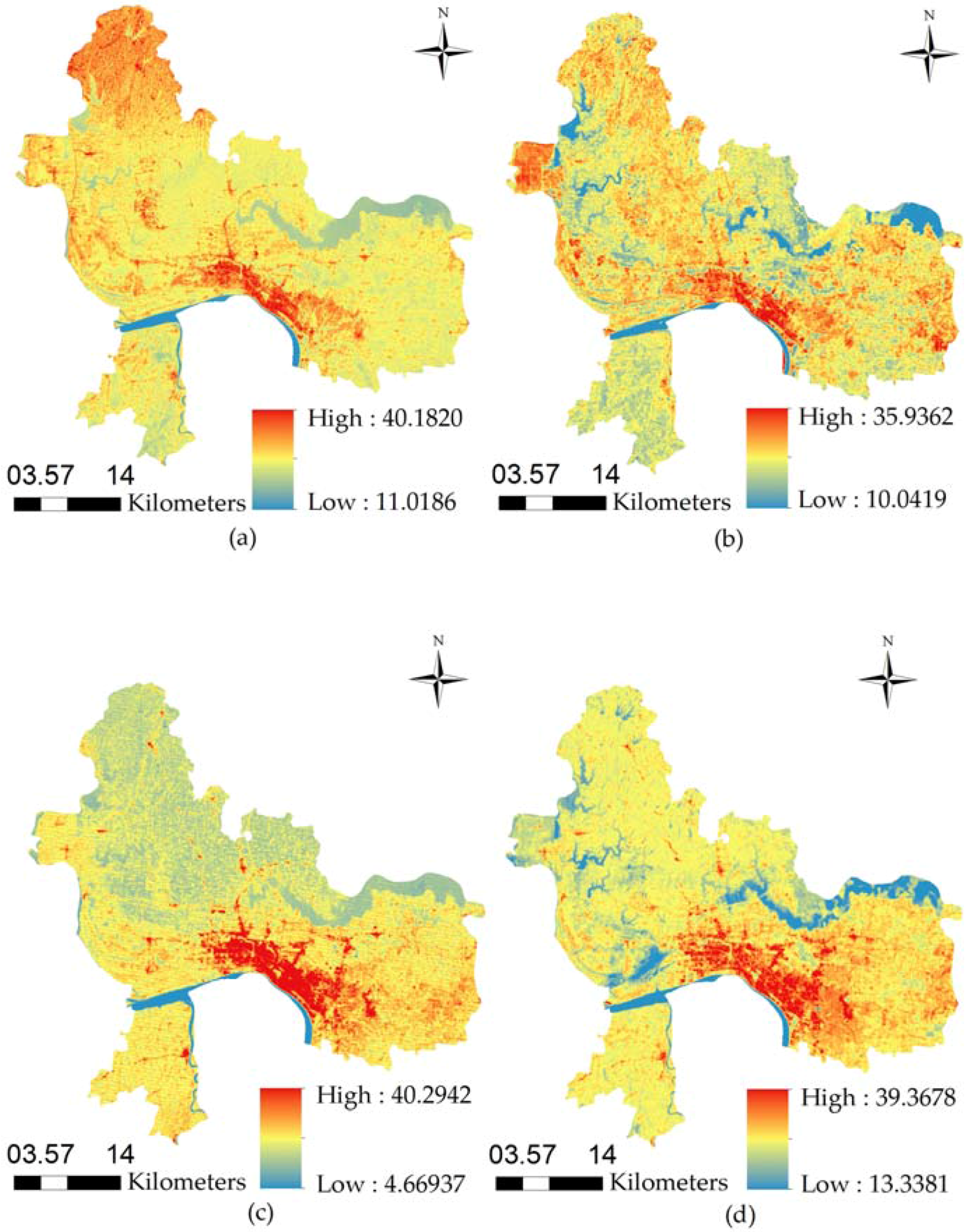



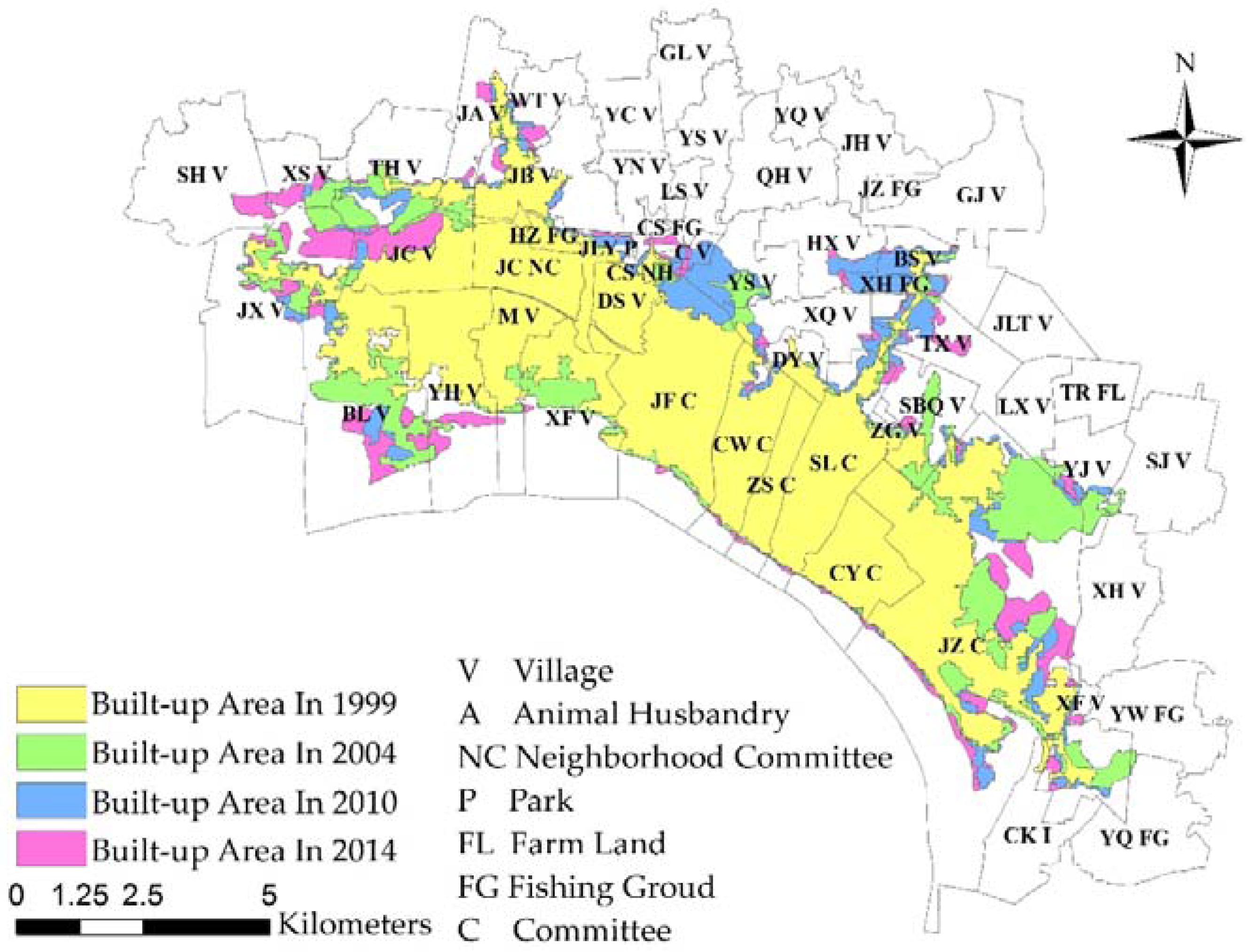
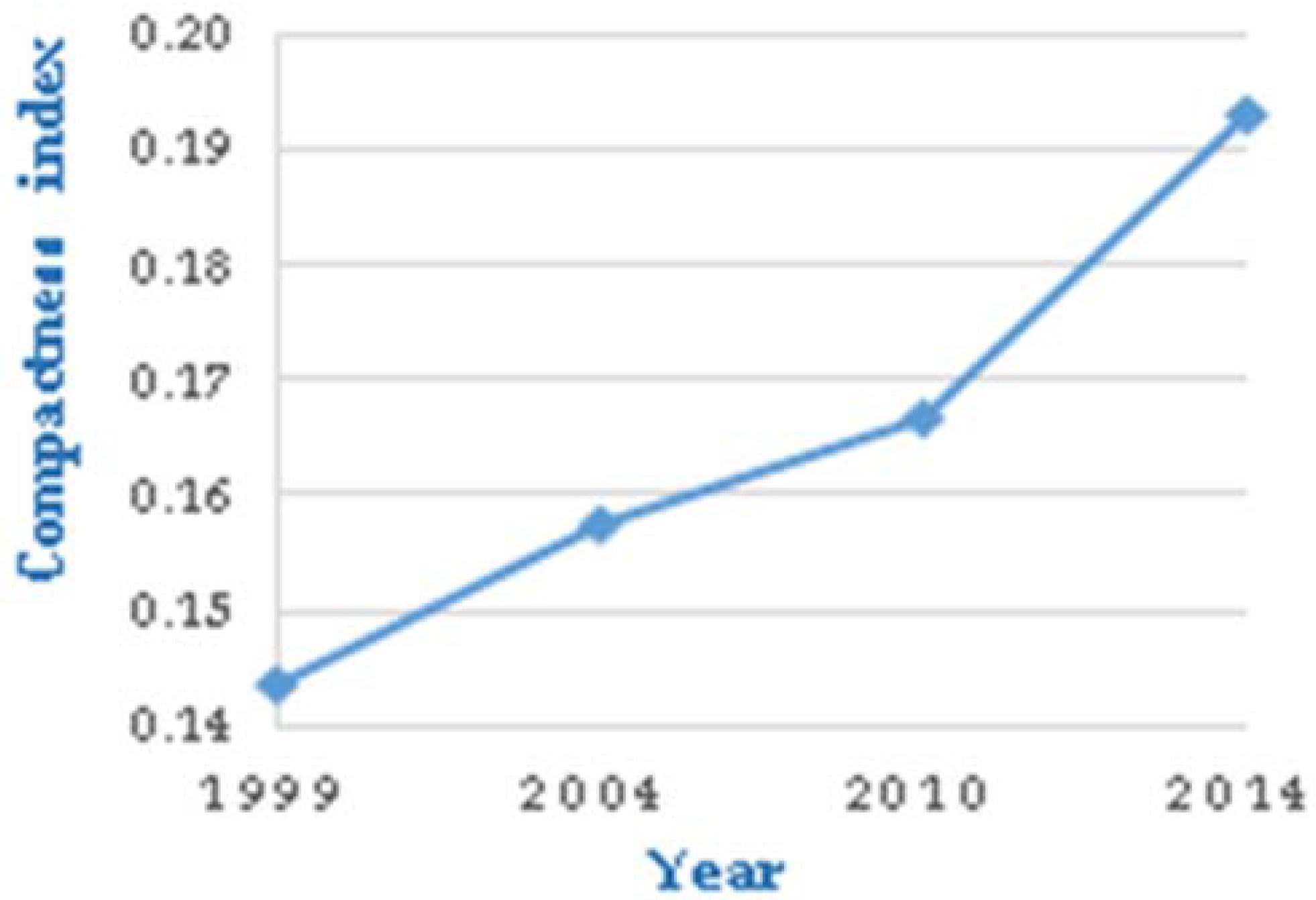

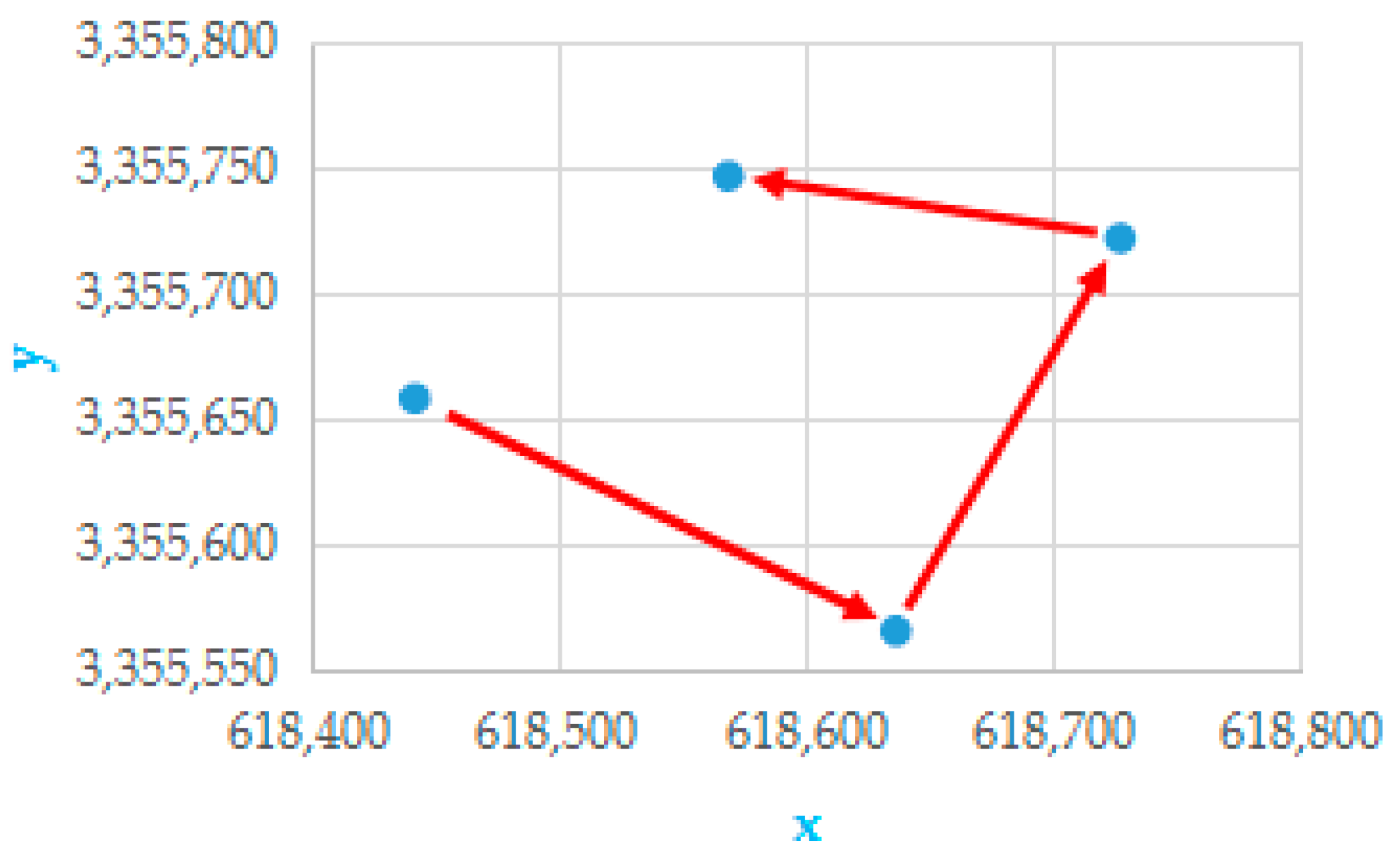
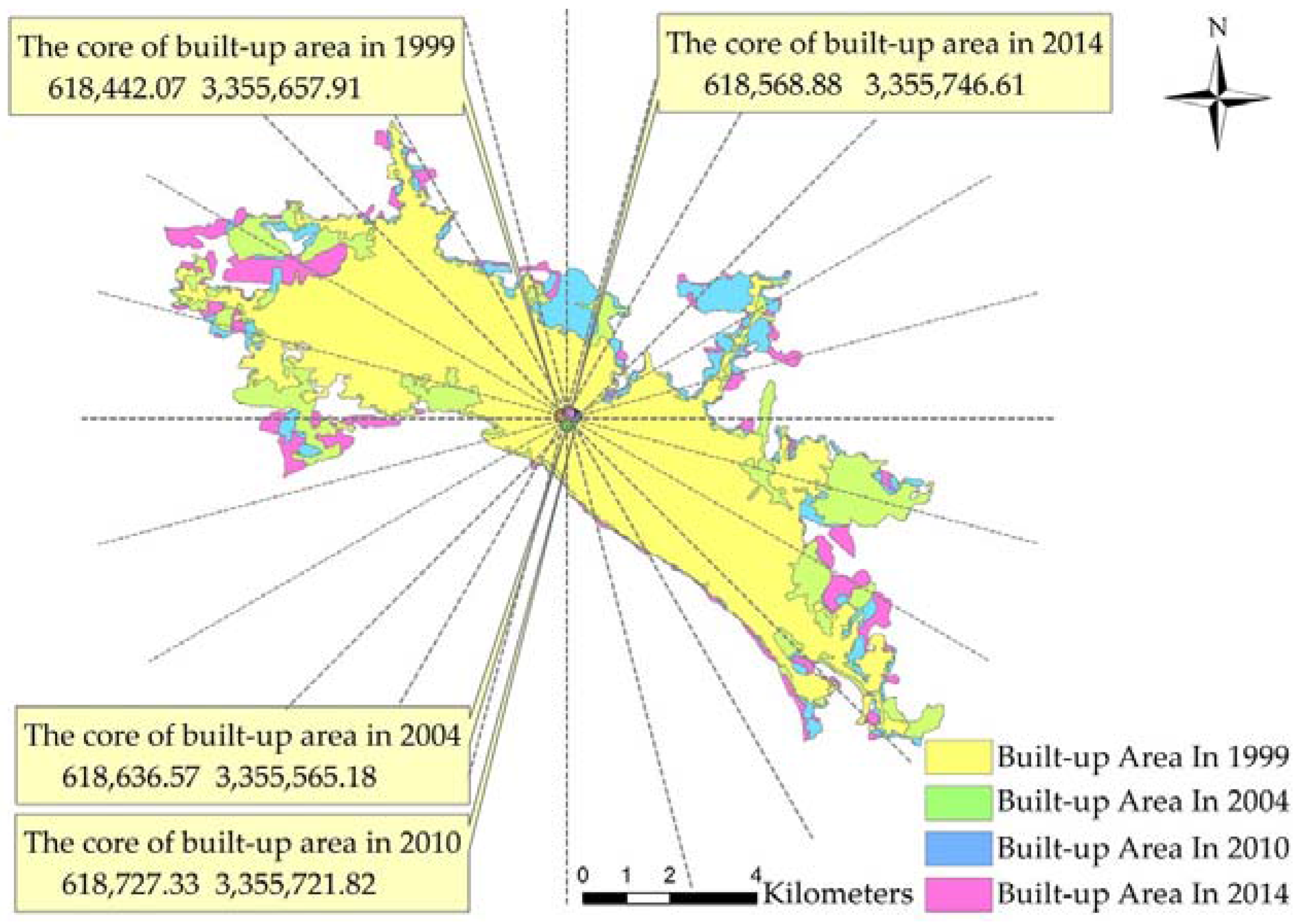
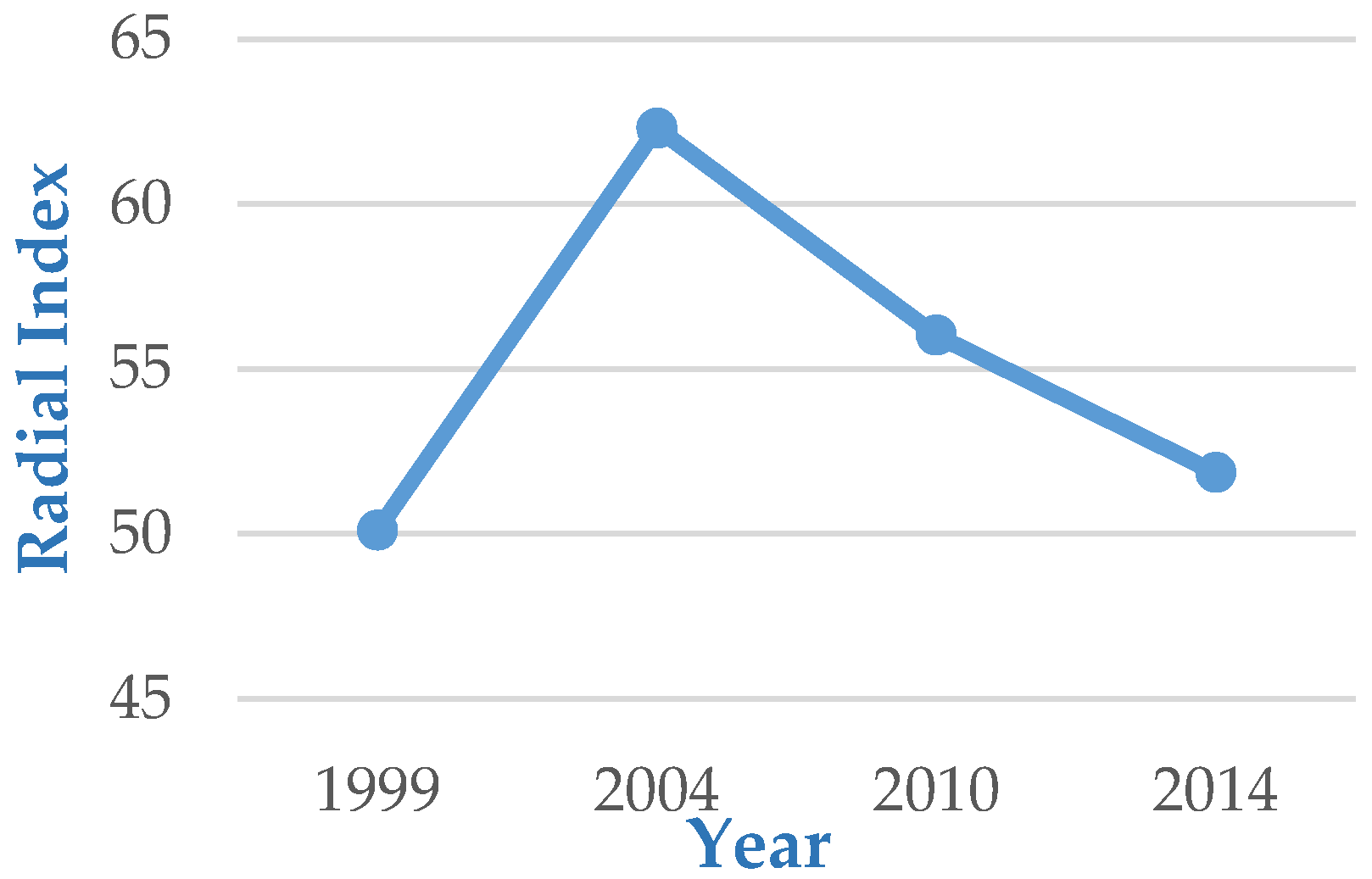


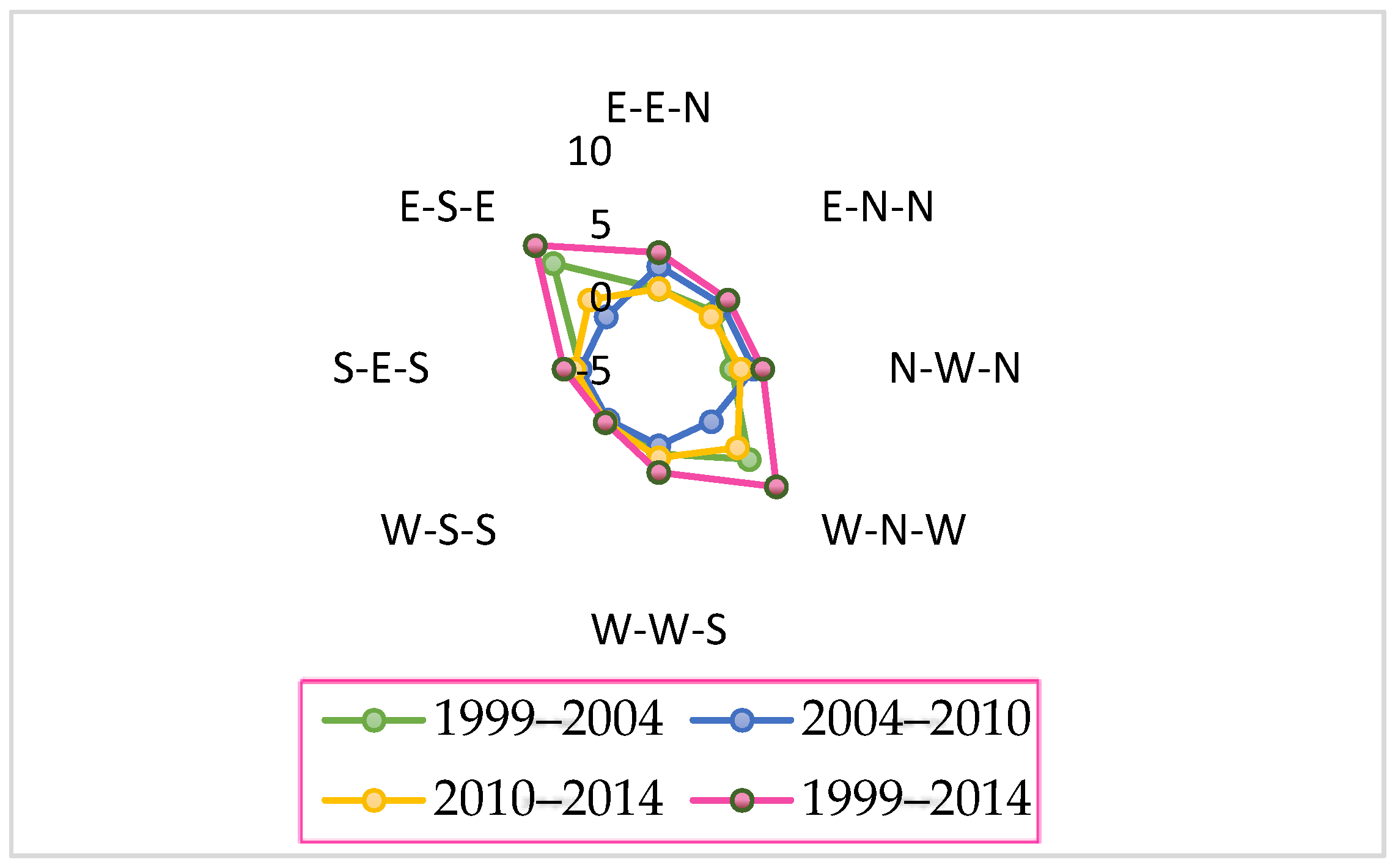
| Satellite | Sensor | Day | Time | Spectral Band | Resolution |
|---|---|---|---|---|---|
| Landsat 5 | TM image | 8 April 2004 | GMT 02:41:57 | 3, 4, 6 | 30, 30, 120 |
| Landsat 5 | TM image | 30 July 2010 | GMT 02:52:55 | 3, 4, 6 | 30, 30, 120 |
| Landsat 7 | ETM image | 10 September 1999 | GMT 02:55:22 | 3, 4, 6 (high gain) | 30, 30, 60 |
| Landsat 8 | OLI_TIRS image | 6 May 2014 | GMT 03:02:07 | 4, 5, 10 | 30, 30, 100 |
| Data Type | Temperature Range (°C) | a | b |
|---|---|---|---|
| Landsat 5 | 0–70 | −67.36 | 0.46 |
| 0–30 | −60.33 | 0.43 | |
| 20–50 | −67.95 | 0.46 | |
| Landsat 7 | 0–70 | −67.36 | 0.46 |
| 20–70 | −70.18 | 0.46 | |
| Landsat 8 | 20–70 | −70.18 | 0.46 |
| 0–50 | −62.72 | 0.44 | |
| −20–30 | −55.43 | 0.41 |
| Constants | K1 (W·m−2·sr−1·μm−1) | K2 | Grescale (W·m−2·sr−1·μm−1) | Brescale (W·m−2·sr−1·μm−1) | ML (W·m−2·sr−1·μm−1) | AL (W·m−2·sr−1·μm−1) | |
|---|---|---|---|---|---|---|---|
| Images | |||||||
| Landsat5 TM (band 6) | 607.76 | 1260.56 | 0.05632156 | 1.238 | N/A | N/A | |
| Landsat7 ETM+ (band 6H) | 666.09 | 1282.71 | 0.0371 | 3.2 | N/A | N/A | |
| Landsat8 TIRS (band 10) | 774.89 | 1321.8 | N/A | N/A | 0.0003342 | 0.1 |
| Atmospheric Profile | Atmospheric Water Content (w) (g/cm−2) | Atmospheric Transmittance Equation | Squared Coefficient of Correlation (R2) | Standard Error of Estimate (SEE) |
|---|---|---|---|---|
| Mid-latitude summer climate | 0.2–1.6 | τ10 = 0.9184–0.0725 w | 0.983 | 0.0043 |
| 1.6–4.4 | τ10 = 1.0163–0.1330 w | 0.999 | 0.0033 | |
| 4.4–5.4 | τ10 = 0.7029–0.0620 w | 0.966 | 0.0081 |
| Ground Emissivity ε | NDVI | Land Cover Type |
|---|---|---|
| ε = εw = 0.995 | NDVI ≤ NDVIW | Water body |
| ε = εs = 0.972 | NDVIW < NDVI ≤ NDVIS | Bare soil |
| ε = 0.004PV + 0.986 | NDVIS < NDVI < NDVIV | Mixed Surface |
| ε = εv = 0.986 | NDVI ≥ NDVIV | Vegetation |
| Ground Emissivity ε | NDVI | Land Cover Type |
|---|---|---|
| ε = εs = 0.991 | NDVI < NDVIW | Water body |
| ε = εs = 0.966 | NDVIW ≤ NDVI < NDVIW | Bare soil |
| ε = 0.973PV + 0.966(1 − PV) + Cλ | NDVIS ≤ NDVI ≤ NDVI V | Mixed Surface |
| ε = 0.973PV + Cλ | NDVI > NDVIV | Vegetation |
| Year | 1999–2004 | 2004–2010 | 2010–2014 |
|---|---|---|---|
| Area increment (km2) | 11.035 | 5.264 | 7.356 |
| Increase rate of area (%) | 21.963 | 8.590 | 11.055 |
| Expansion rate (km2/a) | 2.207 | 0.877 | 1.839 |
| Expansion intensity index (%) | 4.393 | 1.432 | 2.764 |
| Year | Area (km2) | Perimeter (km2) | X Coordinate of Barycenter (m) | Y Coordinate of Barycenter (m) | Compactness Index | Fractal Dimension | Radial Index |
|---|---|---|---|---|---|---|---|
| 1999 | 50.24 | 174.99 | 618,442.07 | 3,355,657.91 | 0.14 | 1.93 | 50.11 |
| 2004 | 61.28 | 176.21 | 618,636.57 | 3,355,565.18 | 0.16 | 1.84 | 62.30 |
| 2010 | 66.54 | 173.47 | 618,727.33 | 3,355,721.82 | 0.17 | 1.80 | 56.02 |
| 2014 | 73.90 | 157.89 | 618,568.88 | 3,355,746.61 | 0.19 | 1.71 | 51.86 |
| Direction | 1999 | 2004 | 2010 | 2014 |
|---|---|---|---|---|
| East-east-north | 2.63 | 3.08 | 5.09 | 5.57 |
| East-north-north | 1.30 | 1.77 | 2.92 | 2.98 |
| North-west-north | 6.47 | 6.46 | 7.95 | 8.56 |
| West-north-west | 16.86 | 20.58 | 20.63 | 23.22 |
| West-west-south | 1.06 | 1.84 | 2.07 | 3.12 |
| West-south-south | 0.64 | 0.74 | 0.66 | 0.79 |
| South-east-south | 5.98 | 6.32 | 6.68 | 7.45 |
| East-south-east | 15.30 | 20.48 | 20.55 | 22.22 |
| Total | 50.24 | 61.28 | 66.54 | 73.90 |
| Mean | 6.28 | 7.66 | 8.32 | 9.24 |
| Standard deviation | 6.03 | 7.68 | 7.43 | 8.13 |
| Direction | 1999–2004 | 2004–2010 | 2010–2014 | 1999–2014 |
|---|---|---|---|---|
| East-east-north | 0.45 | 2.01 | 0.48 | 2.94 |
| East-north-north | 0.47 | 1.16 | 0.05 | 1.68 |
| North-west-north | −0.01 | 1.48 | 0.61 | 2.09 |
| West-north-west | 3.72 | 0.06 | 2.58 | 6.36 |
| West-west-south | 0.78 | 0.23 | 1.05 | 2.05 |
| West-south-south | 0.10 | −0.09 | 0.13 | 0.15 |
| South-east-south | 0.35 | 0.35 | 0.77 | 1.47 |
| East-south-east | 5.18 | 0.06 | 1.68 | 6.927 |
| Total | 11.04 | 5.26 | 7.36 | 23.66 |
| Expansion rate | 2.21 | 0.88 | 1.84 | 1.58 |
| Standard deviation | 1.82 | 0.73 | 0.794 | 2.25 |
| Period | 1999−2004 | 2004−2010 | 2010−2014 |
|---|---|---|---|
| S(i) | 4.39 | 1.43 | 2.76 |
| Pop(i) | 0.51 | 0.32 | −0.32 |
| R(i) | 8.55 | 4.42 | −8.54 |
© 2018 by the authors. Licensee MDPI, Basel, Switzerland. This article is an open access article distributed under the terms and conditions of the Creative Commons Attribution (CC BY) license (http://creativecommons.org/licenses/by/4.0/).
Share and Cite
Wang, L.; Zhu, J.; Xu, Y.; Wang, Z. Urban Built-Up Area Boundary Extraction and Spatial-Temporal Characteristics Based on Land Surface Temperature Retrieval. Remote Sens. 2018, 10, 473. https://doi.org/10.3390/rs10030473
Wang L, Zhu J, Xu Y, Wang Z. Urban Built-Up Area Boundary Extraction and Spatial-Temporal Characteristics Based on Land Surface Temperature Retrieval. Remote Sensing. 2018; 10(3):473. https://doi.org/10.3390/rs10030473
Chicago/Turabian StyleWang, Lin, Jianghong Zhu, Yanqing Xu, and Zhanqi Wang. 2018. "Urban Built-Up Area Boundary Extraction and Spatial-Temporal Characteristics Based on Land Surface Temperature Retrieval" Remote Sensing 10, no. 3: 473. https://doi.org/10.3390/rs10030473
APA StyleWang, L., Zhu, J., Xu, Y., & Wang, Z. (2018). Urban Built-Up Area Boundary Extraction and Spatial-Temporal Characteristics Based on Land Surface Temperature Retrieval. Remote Sensing, 10(3), 473. https://doi.org/10.3390/rs10030473



